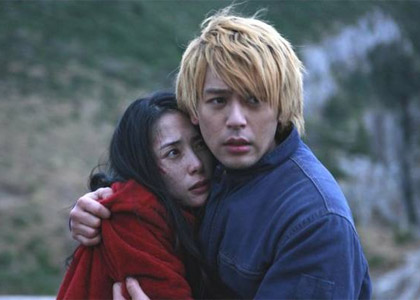JET Publications Round-Up
The summer issues are out! Check out the latest from JET publications around the country!
- Nagasaki‘s Nagazasshi
- Summer Issue available now!
- Nagano‘s Yomoyama
- Summer Issue (Natsukashii) is out now!
WIT Life #176: 悪人
WITLife is a periodic series written by professional Writer/Interpreter/Translator Stacy Smith (Kumamoto-ken CIR, 2000-03). She starts her day by watching Fujisankei’s newscast in Japanese, and here she shares some of the interesting tidbits and trends together with her own observations.
First off a huge OMEDETOU to the Japanese women’s soccer team for winning the World Cup over the weekend! I watched the game with the Japanese delegation I have just begun interpreting for, and needless to say it made our night. The victory has been a nice boost of encouragement for the country, and is something all of its citizens can take pride in.
The Japan Cuts film festival at Japan Society is going strong in its second and final week, and in my next few entries I hope to discuss some of the great movies I’ve been seeing. But today I’d like to talk about another interesting film that made its New York premiere when it was screened last week as part of the Nippon Eiga series sponsored by ANA. It was 悪人 (Akunin) or Villain, and featured the two amazing actors Satoshi Tsumabuki (as the villain) and Eri Fukatsu (as the woman who falls in love with him). It was directed by Sang-il Lee who also made Hula Girls, another movie that was screened as part of ANA’s series a few years back.
Fukatsu received the Best Actress award at the Montreal World Film Festival last year for playing this role, a worthy performance. She and Tsumabuki always have great chemistry (I loved them in Read More
Japan Women Win World Cup!
Omedetou to Japan Women’s Soccer for an amazingly resilient World Cup victory!
The JET Alumni community everywhere is cheering.
Honto ni o-tsukare sama deshita.
Posted by Tom Baker (Chiba-ken, 1989-91), coauthor of The Sushi Lover’s Cookbook and Tokyo Chic and contributor to Time Out Tokyo and Time Out Shortlist Tokyo. He blogs as “Tokyo Tom Baker.”
Did you ever go to the beach during your time in Japan? In particular, did you ever visit Suma beach in Kobe? Photographer Robin Haseba has an exhibition of portraits of Suma beach-goers currently running in Shinjuku, Tokyo, that may bring back some memories.
When I visited the show on its opening day, I briefly met Haseba and later sent him some questions by e-mail for an article on my blog. You can read my comments on Haseba’s work, and see some examples of it, here.
WIT Life #175: Japan Cuts 2011
WITLife is a periodic series written by professional Writer/Interpreter/Translator Stacy Smith (Kumamoto-ken CIR, 2000-03). She starts her day by watching Fujisankei’s newscast in Japanese, and here she shares some of the interesting tidbits and trends together with her own observations.
The 2011 Japan Cuts Film Festival at Japan Society is back and better than ever, with a lineup of 32 films and 33 screenings in total. Like last year, I decided to volunteer in various roles such as ushering and ticket taking, as that allows you to stick around and enjoy the movies. The first movie I worked at was Love & Loathing & Lulu & Ayano (名前のない女たち) which was screened this past Friday night.
Director Hisayasu Sato, known as one of the “Four Heavenly Kings of Pink” for his work in ピンク映画 (pinku eiga) or soft-core porn films, incorporated his background into this movie released in Japan last year. It tells the story of a meek OL who is scouted in Shibuya to work in Read More
Video: “Tonoharu” explained in unique video by creator Lars Martinson
****************
Lars Martinson (Fukuoka-ken 2003-2006), author of the graphic novels Tonoharu: Part Two and Tonoharu: Part 1, has put together a rather unique video that “explains” the Tonoharu series in a marvelously tongue-in-cheek way. (BTW, does anyone know if there’s a Japanese term for “tongue-in-cheek”?)
Anyway, have a look at the video. I think it’s fair to say that no one has captured the JET/living in Japan experience in as intricate a way as Lars has:
JET ROI: “The JET Program’s Finest Hour”
David Jacobson, a former Monbusho Scholar who now works for Seattle-based Chin Music Press (founded by former Monbusho English Fellow Bruce Rutledge), has just posted a really terrific piece titled “The JET Program’s Finest Hour“ about the role of JET and JET alumni in response to the Tohoku Earthquake Disaster. David did a particularly effective job of documenting the topic and pulling information together in a way that had not been done to date. And it demonstrates a very clear “Return on JET-vestment.”
Here’s the link: http://chinmusicpress.com/blog.php?action=display&entryID=13
David comments that the JET Program’s “support this spring, in the aftermath of the devastating March 11 Tohoku earthquake and tsunami, may have marked the program’s finest hour.” And his research helps document information such as:
“Within hours after the disaster, Eric Butler, a former JET who lives in Calgary, Alberta, created a Facebook page, Foreigners from Miyagi. He intended it as a place to discuss how to help the quake victims, but within days it attracted nearly 700 users, many in Japan, and morphed into a forum for those seeking the whereabouts of JETs or others in disaster areas.”
The article also acknowledged and put JETwit’s role in perspective in the larger context:
“Editor (and JET alumnus) Steven Horowitz began a similar effort providing up-to-the minute updates on JETwit, a blog that has evolved into the de facto central information source for the JET alumni community. But he also saw his role as helping JET alums become involved in the relief effort, listing opportunities for volunteers, translators, even offering practical advice for those in Japan. And he recommended that JETs get the word out: “Make yourself available to talk to schools, churches, companies, other organizations. Engage your grad school or college alumni offices. Wear a button that says, ‘Ask Me About Japan.’”
JET Prefecture Round-Up 07.05.11
**************
Emily Lemmon, (Hyogo-ken, Shiso-shi, 2009-present), PSG volunteer, organizer of Hyogo-ken’s PEPY Ride, student of Shorinji Kempo, and editor of the Hyogo Times, gives a little taste of what JETs are doing around Japan. To submit items for future JET Prefecture Round-up posts, e-mail Emily at jetinfogather [at] gmail.com.
Events by Region
- Iwamizawa International Mini Festival was June 18th at Higashiyama Park, and included international food and drink, as well as face painting, Smores, 3 craft tables, board games from around the world, an obstacle course, salsa dancing, national anthems, Ebingo and many more great activities for everyone to enjoy.
- Leavers’ Party (“Towada Renaissance”) will be Saturday July 9th, from 1pm until everyone falls asleep.
- 2011 Tohoku Summer Retreat – JET Christian Fellowship retreat will be held from July 16th to 18th at the Aomori Christian Center in Moya Hills, Aomori City (registration required).
- Annual Cabin Sayonara Party will be July 16th at the Yakehashiri cabins.
- Iwate JETs were invited to attend the earthquake debate session on June 16th, to share stories of the March 11 disaster and how they got news or information.
- Akita JETs are lending traditional costumes from their home countries to students of the Akita University Network for their July 10th International Festival.
Chubu Region
- The Giant Jumping Monkey – a charity bash held in Myoko on July 2nd, rain or shine, features guest DJs, a monkey bounce-house, camping, and BBQ. All proceeds to Tohoku
- ZAZA Arts Festival and Charity Event presented by AJET Nagano and Arriba Arriba Cafewill be at Ikirou near Kamishiro Stationn in Hakuba on July 9-10th: an arts, music, and performance event featuring the great people of Nagano!
- Shimosuwa was one of the first towns in the prefecture to introduce a comprehensive English curriculum into elementary schools. July 18th is the 4th annual Kid’s Expo at Shimosuwa Cultural Center; This years theme is “Japan, connections to the world” . JET volunteers may showcase their countries or a cultural activity in a mini Expo style booth and give the kids a chance to interact in English.
- KoiKoi Matsumotos, a big international festival, was held on June 26th at M-Wing, Matsumoto’s chuo kominkan. About 20 countries were represented with various shows, games, presentations, kids’ activities, an international food court, and more. Entry was free, food was cheap, and profits went to help the relief effort in Tohoku area.
- Bai Bai Beach Party to be held July 24th at Uchinada Beach.
Kansai Region
- Path of Prayer continues on July 3rd; participants will walk from Nakahechi Michi-no-eki to Kobiro oji on the Kumano Kado, invoking a speedy recovery for Tohoku while experiencing this historic trail.
- Kozagawa Kayaking and Camping will take place from July 9th to the 10th on the Koza River, Wakayama.
- Nara’s farewell to leaving JETs, the Bye Bye Bash,complete with awards, was held at the Tousembou Kidaku on June 17th.
- Ultimate Frisbee practice and BBQ in the Goon on June 18th.
- Taj Ultimate, the Ultimate Frisbee Tournament, will be held July 9th and 10th.
- “There is Hope Through Music” for Tohoku – On July 9th, Ehime JET Dan will gather fellow JETs to the Asakura Kominkan in Imabari to record videos with the fireman brass band. The videos will be combined with videos from the Kurosawa Piano Music Foundation of California and broadcast both online and to the victims in refugee camps in Japan.
- Sayonara Party will be July 9th at Kashima Island.
- July 10th, Ehime JETs are invited to a tea ceremony in Imabari.
- Students now have until July 15th to apply for the Genki Scholarship for International Exchange, 2011. The Genki Scholarship hopes to assist Kochi-based students fulfil their ambitions of going on international exchange, to expand their horizons and improve their communication skills. This year’s Genki Tosaben Musical generated enough funds to provide for a scholarship of approximately 200,000 yen (exact amount depends on number of applicants, where and for how long they’re going), plus a donation of up to 100,000 yen for Tohoku’s Disaster Relief.
- The JET Farewell party and beer garden was held June 17th.
- Organic Rice Planting volunteers have been pushed back to July 2nd for lack of rain! Preparing to get muddy, JETs will assist in the labor intensive work of organic farming.
- Sayonara Party – Oita JETs say farewell on July 9th in Oita City.
- Oita JETs make a camping trip to Miyazaki Prefecture on July 23rd-24th.
- An Oita JET is organizing volunteers to help a family maintain their farm and orchard. Activities include but are not limited to: raking leaves, pruning trees, cutting grass, weeding, and setting up a wire fence.
- June 18th, the Oita International Plaza held the monthly Japanese Conversation Circle, pairing native and non-native speakers for 15 minutes and then switching partners. Participants talk freely or use materials provided based on a topic. June’s topic was talking about your hometown.
- The ‘Japan-British Society of Kumamoto’ is holding their annual ‘Tanabata “Star Festival” Party’ at 6:30PM on Friday, July 1st. This event was a huge success last year with scores of Japanese and foreigners eating, drinking and socialising in celebration of this traditional Japanese festival.
- Former Nagasaki ALT shares video from Golden Week in Tohoku here.
- This year’s international exchange party by Miyazaki City International Association (MCIA) was June 17th at the Miyazaki Shimin Plaza.
- Kagoshima’s Bon Voyage Bash will be July 9th at the Sun Royal Hotel.
WIT Life #174: Saga Setting the Nuclear Standard
WITLife is a periodic series written by professional Writer/Interpreter/Translator Stacy Smith (Kumamoto-ken CIR, 2000-03). She starts her day by watching Fujisankei’s newscast in Japanese, and here she shares some of the interesting tidbits and trends together with her own observations.
Yesterday’s NYT had an interesting article about Japan’s nuclear policy going forward. Increasingly local governments are being depended on to determine this, though they believe these are decisions the central government should be making. Currently the debate is taking place in the rural prefecture of Saga located in Kyushu, where battle lines are drawn between nuclear power plant operators who insist their facilities are safe and wary citizens. In the middle is Saga governor Yasushi Furukawa who is being looked to for approval or rejection of restarting two of the four reactors at the plant. After being shut down for routine maintenance, the question is whether Read More
Job: Cultural Affairs Assistant (Houston, TX)
Via PNWJETAA. Posted by Dipika Soni (Ishikawa-ken, 2003-06). Dipika has recently moved back to London and is currently looking for new work opportunities related to Japan, translation, or other fields.
———————————————————————————————————————————-
***Note: If you apply for this position, please let them know you learned of it from JETwit. Thanks.***
Job Position: Cultural Affairs Assistant (Houston, TX)
Job Details:
Primary Duties & Responsibilities:
JET Publications
Check out the latest updates on the JET publications from around the country!
- Nagano‘s Yomoyama
- Spring Issue is out now; they are accepting submissions for the Summer issue!
WIT Life #173: Homeless by mandate
WITLife is a periodic series written by professional Writer/Interpreter/Translator Stacy Smith (Kumamoto-ken CIR, 2000-03). She starts her day by watching Fujisankei’s newscast in Japanese, and here she shares some of the interesting tidbits and trends together with her own observations.
Almost four months have passed since the earthquake/tsunami hit Japan, and one might think that after this amount of time things have gotten back to some semblance of normal. That seems to be the case for the most part in Tokyo, where except for limited electricity usage and the omnipresent uncertainty regarding radation levels, it is back to business as usual. However, for those who lived in the disaster area, it is a different story. I recently spoke to a close friend over Skype, who told me about her brother who had lived with his family in Tohoku.
They, like many others from the disaster zone, cannot be cleared to return home due to restrictions on entering areas that exceed a certain level of radiation. Instead, they have spent the last few Read More
Volunteer to become a Host Family for Exchange Students from China, Korea or Japan
via Carleen Ben (Oita-ken 2006-2008) Carleen currently works as a Program Associate at The Laurasian Institution, a non-profit organization promoting international exchange programs between US – China, Japan, and Korea.
Volunteer Host Family:
Remember your time in Japan or as a study abroad student where you were welcomed by super amazing host families? Do you miss sharing your culture and learning about new ones??
Single parents, retirees, “empty nesters,” young couples with small children, as well as more traditional two parent families with teenagers/pets, all are currently sharing and enjoying the exchange experience!
If you are interested in hosting a student or know of someone who is interested, please email us at ayp@laurasian.org
We are looking for host families in all states throughout the US!
Students’ arrival date: August 13th 2011
End of the program: June 2012 (when host school’s term is over)
Host Families are important members of the U.S. Department of State’s citizen diplomats. If you are interested in being part of this program and the larger picture of supporting public diplomacy, please contact us! Feel free to ask us any questions. We are looking forward to hearing from you soon!
Yoroshiku oneigaishimasu!
National AJET’s Life After JET: David Leung
National AJET
shares former JET participants’ experiences – and a little advice – with current JETs in their new monthly interview, Life After JET. Contact lifeafterjet [at] ajet.net to be featured in future posts.
*************
David Leung (Nagasaki, 2009-2010) walked us through his decision to leave JET and eventually finding his way to his current position as Graduate Policy Officer for the State Department of Further Education, Employment, Science and Technology back in Australia.
NAJET: When in the JET-year did you decide not to re-contract?
David: It was the toughest decision to make, whether or not to recontract. It is usually the worst time of the year for most JETs to carry such a heavy burden, either having just settled in, or in the most serious bouts of wintery homesickness.
For me, from the very beginning, it was always an open option to stay for as long as I could enjoy the experience and be of use to my local community on Fukue Island. The main reason I was still debating at the 11th hour wasn’t because I didn’t enjoy my work (I loved my schools, my Japanese colleagues and the kids), my social life (I had the closest network of JET teachers, who will remain some of my closest friends for the rest of my life, and was a member of the warmest Taiko Team you could imagine) or the environment (fresh local produce and delicious Goto udon that you must try, the friendliest neighbours, and the most gorgeous tropical island with beaches). It was the fact that I left the love of my life back home in Australia. When it came down to it, choosing to stay would be choosing a life for me, and choosing not to recontract meant choosing a life together with my partner.
NAJET: What’s important for JETs to do once they decide not to re-contract?
David: The two toughest things to do is to keep up the energy and try to pack in as much experience as you can in the time left. I found that I subconsciously began to distance myself from all aspects of life, I guess as a defence mechanism against the inevitable pain of leaving a year’s worth of relationships, work and stories.
Make a list of things that you want to do, either mentally or written down. This list doesn’t just include experiences that you can only do in Japan or your local community, but also making the time to say proper goodbyes with people that have become close to you over the past year(s) you may not see ever again. As time to go draws near, time speeds up; your mind will wander to the future, leaving less time and space for the present – having the list helps you keep focused and in the here and now.
Make the effort to say goodbye to your school(s) and exchange contact details with those nearest and dearest to you. You never know with whom you will want to stay in touch during a lonely moment after a few months of being back at home.
Don’t underestimate the amount of luggage you will want to bring home, and be prepared for bulky and impractical (but wonderfully sentimental and treasured) goodbye gifts from people you’d least expect.
NAJET: How did you get started on your job search when you returned home?
David: As soon as I decided to return home, I started my job search online via the numerous jobseeker support websites here in Australia. I had plenty of conversation with my partner, my family and my friends, all of whom were splendid sources of support and advice.
I had a pretty clear idea of where I wanted to be – education policy. Having worked in rural Japan, I saw areas of improvement in local government policy and funding decisions first-hand, yet could do nothing about it at the teaching level.
Click here for the rest of the interview.
WIT Life #171: Radiation fallout (both literal and emotional)
WITLife is a periodic series written by professional Writer/Interpreter/Translator Stacy Smith (Kumamoto-ken CIR, 2000-03). She starts her day by watching Fujisankei’s newscast in Japanese, and here she shares some of the interesting tidbits and trends together with her own observations.
As more information comes out regarding the lack of disclosure as well as intentional cover-up that took place regarding Japan’s nuclear crisis, people are becoming more and more empowered. This article from Sunday’s New York Times details how citizens have begun protesting, a relatively rare action in Japan. This longer article from this morning’s NYT discusses how little PM Kan knew about what was actually happening.
Media reporting on this issue tends to be either sensational or opaque, so I really value the “on the ground” reports I periodically receive from friends in Tokyo. Here’s an excerpt from a recent mail (long but worth reading) from a close friend describing the continually changing information being provided to them, as well as her thoughts regarding the situation going forward. It provides a backdrop that illuminates why the normally docile Japanese have been taking to the streets:
“Here life is slowly returning to “normal,” but still lots of worries about the radiation affecting Tokyo and outlying areas. There are new setbacks to the nuclear plant situation each day and we wonder Read More



